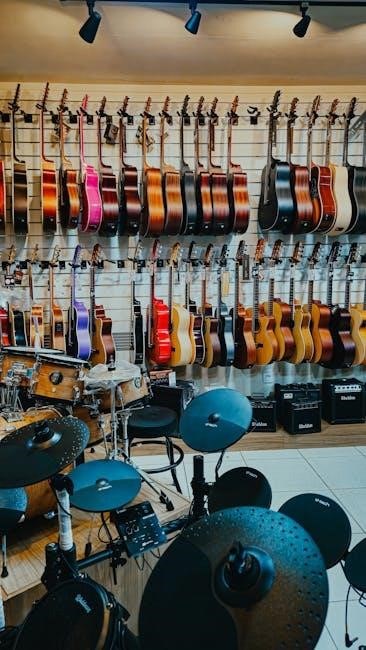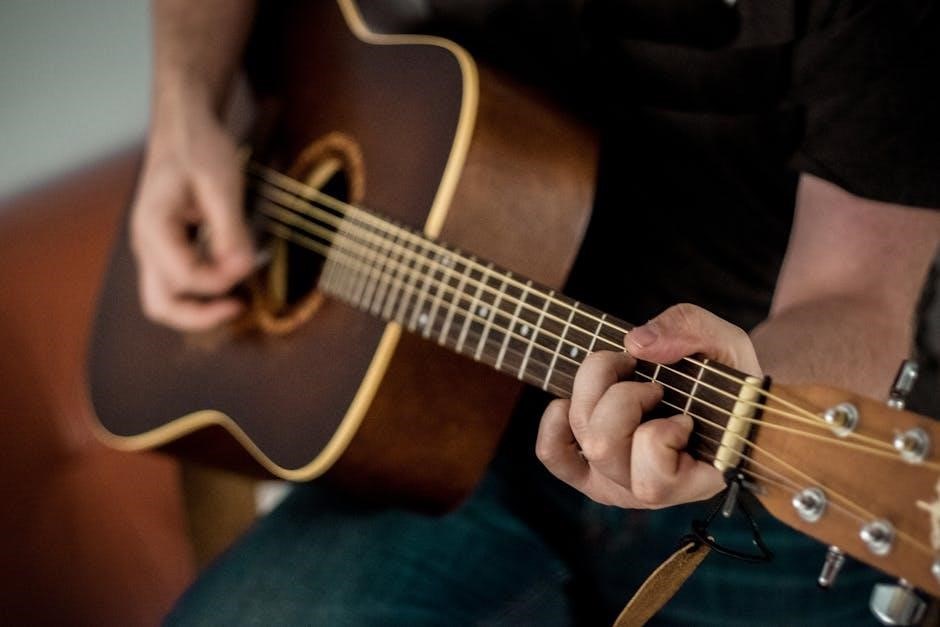Understanding Basic Guitar Chords
Mastering basic guitar chords is essential for any beginner․ Chords are groups of notes played together, forming the foundation of songs․ Understanding chord structures, root notes, intervals, and string placements is crucial for a strong foundation; Start with simple chords like C, G, and D to build finger strength and coordination․ Practice chord transitions smoothly to enhance your playing skills and confidence․ Learning basic chords opens the door to playing countless songs and exploring more complex techniques․ Consistent practice is key to mastering these fundamental elements of guitar playing․
Guitar chords are the building blocks of music, created by playing multiple strings simultaneously․ They form the foundation of songs, allowing musicians to express emotions and create harmony․ Chords can be major, minor, or altered, each producing a unique sound․ For beginners, understanding chord charts and diagrams is essential to identify string placements and finger positions․ Chords like C, G, and D are fundamental, often used in various genres․ Learning these basics helps develop finger strength and coordination․ Chord transitions are crucial for smooth playing, and consistent practice enhances overall musicality․ With dedication, mastering guitar chords opens the door to exploring complex techniques and creating beautiful music․ Whether you’re playing acoustic or electric, chords are the heart of guitar playing, offering endless possibilities for creativity and expression․
Importance of Learning Basic Chords
Learning basic guitar chords is fundamental for any aspiring musician․ Chords form the backbone of music, enabling players to create harmonious sounds and express emotions effectively․ Mastering basic chords provides a solid foundation for playing songs, improvising, and composing music․ They are versatile, applicable across various genres, from rock to folk․ Basic chords like C, G, and D are essential for beginners, as they are commonly used in many songs․ Understanding these chords helps develop finger strength, dexterity, and coordination, which are critical for advancing in guitar playing․ Moreover, basic chords allow musicians to explore more complex techniques and chord progressions as they progress․ By learning these fundamentals, players gain the ability to accompany vocals, play rhythm guitar, and create rich, layered sounds․ This foundational knowledge is indispensable for any guitarist aiming to grow in their musical journey․
Structure of a Basic Chord
A basic guitar chord is a group of notes played simultaneously, creating a harmonic sound․ It is typically built from a root note, a third, and a fifth, forming a triad․ The root note defines the chord’s name and pitch, while the third adds a major or minor quality․ The fifth completes the chord, providing stability․ For example, a C Major chord consists of C (root), E (major third), and G (perfect fifth)․ Chords can also include additional notes, such as sevenths, to add complexity․ Understanding the structure helps in learning chord shapes and variations․ Chords are often played on adjacent strings, with fingers pressing multiple notes․ Proper finger placement and string selection are key to clear, resonant sounds․ Grasping the structure of basic chords simplifies learning more complex chords and enhances overall guitar playing skills․ This foundational knowledge is vital for every guitarist․
Types of Basic Guitar Chords
Basic guitar chords include major, minor, seventh, diminished, and augmented chords․ Each type has a unique sound and structure, essential for creating various musical styles․ Mastering these is fundamental for all guitarists․

Major Chords
Major chords are among the most commonly used chords in music, known for their bright and uplifting sound․ They consist of a root note, a major third, and a perfect fifth․ For example, a C major chord comprises the notes C, E, and G․ These chords are foundational for many genres, including rock, pop, and classical music․ Learning major chords is essential for any guitarist, as they form the basis of numerous songs and progressions․ Practicing major chords helps build finger strength and improves dexterity․ Start with chords like C, G, D, and E, as they are widely used and easier to play․ Understanding major chords will enhance your ability to play and compose music effectively․
Minor Chords

Minor chords are another fundamental chord type, characterized by their sad or melancholic sound․ They consist of a root note, a minor third, and a perfect fifth․ For instance, an A minor chord is made up of the notes A, C, and E․ These chords are widely used in various music genres to evoke emotions and create mood․ Learning minor chords is essential for adding depth and variety to your playing․ Start with common minor chords like A minor, E minor, and C minor, as they are frequently used in songs․ Practicing minor chords will help you develop finger strength and improve your ability to play smoothly․ Minor chords are also a great way to add complexity to your music, making them a vital part of any guitarist’s toolkit․ Mastering minor chords will expand your musical expression and enhance your overall playing skills․
Seventh Chords
Seventh chords add a rich, complex sound to music by extending basic triads with an additional note․ They consist of a root, a major third, a perfect fifth, and a minor seventh․ For example, a C major seventh chord includes the notes C, E, G, and B․ These chords are often used to create tension and depth in songs, making them versatile for various musical styles․ Seventh chords can be major, minor, or dominant, each offering a unique tonal quality․ Learning seventh chords enhances your ability to play more intricate melodies and harmonies․ They are particularly useful for jazz and blues music but are also common in pop and rock․ Practicing seventh chords will expand your musical palette and allow you to explore advanced techniques․ Start with common seventh chords like C7, G7, and Am7 to build your skills gradually․
Diminished and Augmented Chords

Diminished and augmented chords are advanced variations of basic chords, offering unique tonal colors․ A diminished chord consists of a root, a minor third, and a diminished fifth, creating a tense, unstable sound․ For example, a C diminished chord includes the notes C, Eb, and Gb․ Augmented chords, on the other hand, feature a root, a major third, and an augmented fifth, producing a bright, unsettling quality․ A C augmented chord includes C, E, and G#․ These chords are less commonly used but add complexity to music․ They are often employed in jazz, classical, and experimental genres to create dramatic effects․ Learning diminished and augmented chords expands your harmonic vocabulary, allowing for more intricate compositions and solos․ Start with common diminished and augmented chords like Cdim and Caug to explore their distinctive sounds and applications․
Essential Chords for Beginners
Mastering basic chords like C, G, D, A minor, and E minor lays the foundation for guitar playing․ These chords are versatile and essential for building simple progressions and songs․
C Major Chord
The C Major chord is one of the most basic and widely used chords in guitar playing․ It consists of the notes C, E, and G, creating a bright, clean sound․ To play a C Major chord, place your ring finger on the third fret of the A string, your middle finger on the second fret of the D string, and your index finger on the first fret of the B string․ The high E string is played open․ This chord is foundational for many songs and is often used in combination with other chords like G and Am; Practicing the C Major chord helps develop finger strength and dexterity․ It’s also a great starting point for understanding chord structure and progression․ Regular practice will make switching to other chords smoother and improve your overall playing flow․
G Major Chord
The G Major chord is a fundamental chord in guitar playing, consisting of the notes G, B, and D․ It is played by placing your middle finger on the third fret of the low E string, your ring finger on the third fret of the A string, and your index finger on the second fret of the high E string․ The B and D strings are played open․ This chord is versatile and widely used in various music genres․ It is an essential chord for beginners, as it forms the foundation of many popular songs․ The G Major chord is also a great way to improve finger placement and strength․ Regular practice will help you play it smoothly and transition to other chords effortlessly․ Mastering this chord is a key step in building your guitar-playing skills and expanding your musical repertoire․
D Major Chord
The D Major chord is a basic and widely used chord in guitar music, consisting of the notes D, F#, and A․ To play this chord, place your index finger on the second fret of the B string, your middle finger on the second fret of the G string, and your ring finger on the third fret of the high E string․ The D string is played open․ This chord is essential for beginners as it is commonly used in many songs and helps develop finger strength․ The D Major chord is also a great tool for transitioning between other chords smoothly․ It is often used in various genres of music, making it a versatile addition to your chord library․ Regular practice will help you master the D Major chord, enhancing your ability to play a wide range of songs․ It is a key chord for building a strong foundation in guitar playing․
A Minor Chord
The A Minor chord is a fundamental chord in guitar playing, consisting of the notes A, C, and E․ To play this chord, place your index finger on the first fret of the B string, your middle finger on the second fret of the D string, and your ring finger on the second fret of the G string․ The A string is played open․ This chord is essential for beginners as it is widely used in many songs and helps develop finger dexterity․ The A Minor chord is a versatile chord that fits well in various musical genres, making it a valuable addition to your chord library․ Regular practice will help you master the A Minor chord, improving your ability to play smoothly and confidently․ It is a key chord for building a strong foundation in guitar playing and is often used in both acoustic and electric guitar music․
E Minor Chord
The E Minor chord is one of the simplest and most commonly used chords in guitar playing․ It consists of the notes E, G, and B․ To play this chord, place your index finger on the first fret of the A string and your middle finger on the second fret of the D string․ The E string is played open, while the remaining strings (B, high E) are not played in this chord․ The E Minor chord is versatile and frequently used in various musical genres, making it a must-learn for beginners․ Its simplicity and rich sound make it a favorite among songwriters․ Regular practice will help you master the E Minor chord, enhancing your ability to play melodies and harmonies smoothly․ This chord is also a great starting point for exploring more complex chords and techniques in guitar playing․ Its emotional depth and ease of play make it a fundamental part of any guitarist’s skill set․

Advanced Basic Chords
Advanced basic chords introduce more complex finger placements and shapes, expanding your musical versatility․ These chords, like barre chords, enhance your ability to play diverse songs and styles effectively․ Regular practice of these chords will improve your technique and open up new creative possibilities for your guitar playing․ Mastering advanced basic chords is essential for building a strong foundation in guitar music and exploring more intricate melodies and harmonies․ They bridge the gap between beginner and intermediate levels, offering a deeper understanding of chord structures and their applications in various musical contexts․ Consistent practice will make these chords second nature, allowing you to focus on expression and creativity in your performances․ These chords are a crucial step toward mastering more complex guitar techniques and repertoire․ They provide a solid framework for further musical exploration and growth as a guitarist․ With dedication, advanced basic chords will become an integral part of your playing style, enabling you to tackle a wide range of musical genres and styles with confidence and precision․ By incorporating these chords into your practice routine, you’ll develop greater dexterity, strength, and control over the guitar, leading to improved overall performance and a broader musical palette․ Embrace the challenge of advanced basic chords to elevate your guitar playing to new heights and unlock endless possibilities in your musical journey․
F Major Chord
The F Major chord is a fundamental chord in guitar playing, often considered a stepping stone to more complex chords․ It is commonly used in various musical genres due to its versatile sound․ To play an F Major chord, place your first finger on the first fret of the second string, your second finger on the second fret of the third string, and your third finger on the third fret of the fourth string․ The first and sixth strings are played open․ This chord requires proper finger placement to ensure all strings ring clearly․ Practice changing between F Major and other chords to improve your transition skills․ The F Major chord is essential for playing songs in keys that rely on this chord, such as pop, rock, and folk music․ Regular practice will help you master its shape and sound, making it a reliable part of your chord repertoire․
B Minor Chord
The B Minor chord is a versatile and widely used chord in guitar music, appearing in various genres such as rock, pop, and classical․ It consists of three notes: B, D, and F#․ To play a B Minor chord, place your first finger on the second fret of the fifth string, your second finger on the fourth fret of the fourth string, your third finger on the fourth fret of the third string, and your fourth finger on the second fret of the second string․ The first string is played open․ This chord shape can feel challenging for beginners due to the stretch required between the second and fourth frets․ However, consistent practice will make it easier over time․ The B Minor chord is essential for creating somber or melancholic sounds in songs, and it pairs well with other chords like G Major and E Minor․ Regular practice will help you master its fingering and sound, making it a valuable addition to your chord library․
B Major Chord
The B Major chord is a foundational chord in guitar playing, often used in various musical styles․ It is composed of the notes B, D#, and F#․ To play a B Major chord, place your first finger on the second fret of the fifth string, your second finger on the fourth fret of the fourth string, your third finger on the fourth fret of the third string, your fourth finger on the second fret of the second string, and play the first string open․ This chord requires a barre with your first finger across the second fret of the first string, which can feel challenging for beginners․ However, with consistent practice, it becomes manageable․ The B Major chord is essential for creating bright, uplifting sounds in music and is commonly used in genres like rock and pop․ Mastering this chord will expand your ability to play complex songs and progressions, making it a valuable addition to your skill set․ Regular practice will help you achieve a clear and clean sound․

E Major Chord
The E Major chord is one of the most commonly used chords in guitar playing, known for its bright and uplifting sound․ It consists of the notes E, G#, and B․ To play an E Major chord, place your first finger on the first fret of the fourth string, your second finger on the second fret of the fifth string, and your third finger on the second fret of the sixth string․ The remaining strings (third, second, and first) are played open․ This chord is fundamental in many musical genres and is often used in combination with other chords like A and B to create powerful progressions․ Beginner guitarists often find the E Major chord relatively easy to learn due to its simple finger placement․ Practicing this chord regularly will help build finger strength and improve your overall playing technique․ It is a versatile chord that will enhance your ability to play a wide range of songs and styles․

Resources for Learning
Explore PDF guides, online tools, and mobile apps to master basic guitar chords․ These resources provide chord charts, interactive lessons, and progress tracking to enhance your learning experience effectively․

PDF Guides for Basic Chords
PDF guides are an excellent resource for learning basic guitar chords, offering clear chord charts and diagrams․ Many websites provide free downloadable PDFs, such as Songsterr or Ultimate-Guitar, which include detailed finger placements and string notes․ These guides often cover essential chords like C, G, D, and minor chords, making them ideal for beginners․ Some PDFs also include progressions and exercises to practice chord transitions․ Additionally, printable chord charts allow learners to reference them without a screen, making practice sessions more convenient․ Advanced PDF guides may include variations like seventh chords or barre chords for intermediate players․ To find reliable PDFs, search for “basic guitar chords PDF” or “hợp âm guitar cơ bản PDF” on music education websites or forums․ Ensure the PDFs are downloaded from reputable sources to avoid low-quality or incorrect chord information․
- Downloadable chord charts with clear visuals․
- Covers essential and advanced chords․
- Printable for convenient practice․
- Available from trusted music websites․

Online Tools for Chord Practice
Online tools are a fantastic way to practice and master basic guitar chords․ Websites like Fender Play, Guitar Tricks, and Yousician offer interactive lessons and exercises tailored for beginners․ These platforms provide step-by-step guidance, video tutorials, and progress tracking to help you improve․ Additionally, tools like Chordie and Songsterr allow you to view chord diagrams, listen to audio samples, and practice along with popular songs․ Many online tools also include features such as chord charts, scales, and metronomes to enhance your learning experience․ Some websites even offer customizable practice plans based on your skill level and goals․ By using these resources, you can practice chords effectively and build a strong foundation for playing guitar․ Online tools are accessible anytime, making them a convenient option for consistent practice and skill development․

- Interactive lessons and exercises․
- Chord diagrams and audio samples․
- Progress tracking and customizable plans․
- Accessible on various devices․
Mobile Apps for Chord Learning
Mobile apps are an excellent resource for learning and practicing guitar chords on the go․ Apps like Fender Play, Yousician, and Guitar Tricks offer comprehensive lessons and exercises specifically designed for beginners․ These apps provide interactive chord charts, video tutorials, and progress tracking to help you master basic chords․ Additionally, apps such as Chordify and ChordBank allow you to explore chord progressions and practice along with your favorite songs․ Many apps also feature gamification elements, making the learning process fun and engaging․ With customizable practice plans and real-time feedback, these tools help you improve your skills efficiently․ Mobile apps are perfect for convenient practice, ensuring you can learn and refine chords anywhere, anytime․
- Interactive chord charts and video tutorials․
- Progress tracking and real-time feedback․
- Customizable practice plans․
- Accessible on smartphones and tablets․